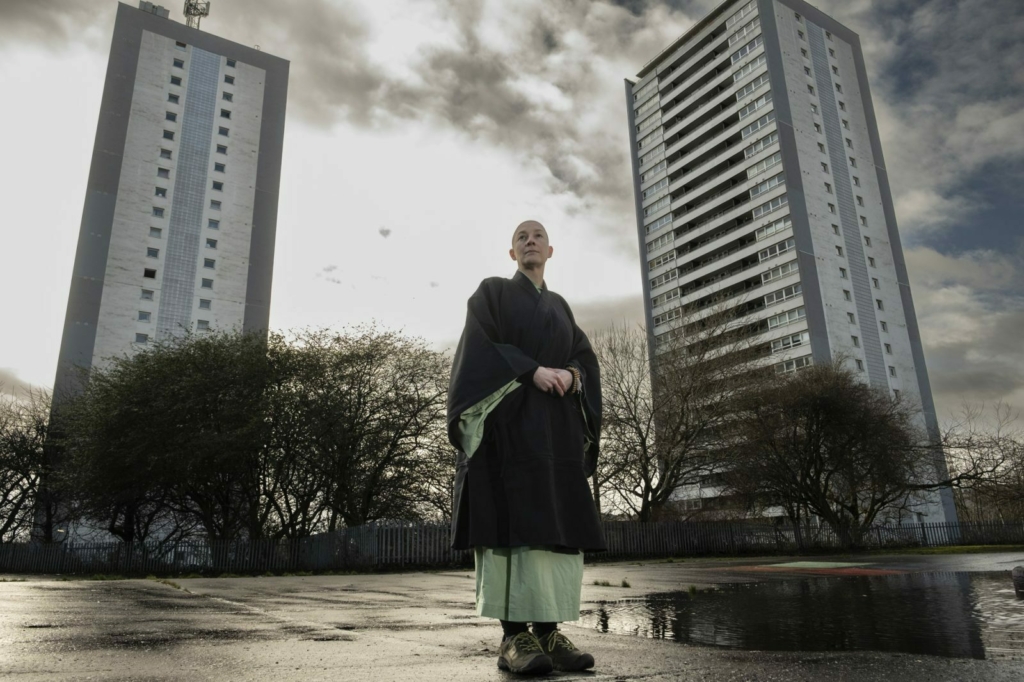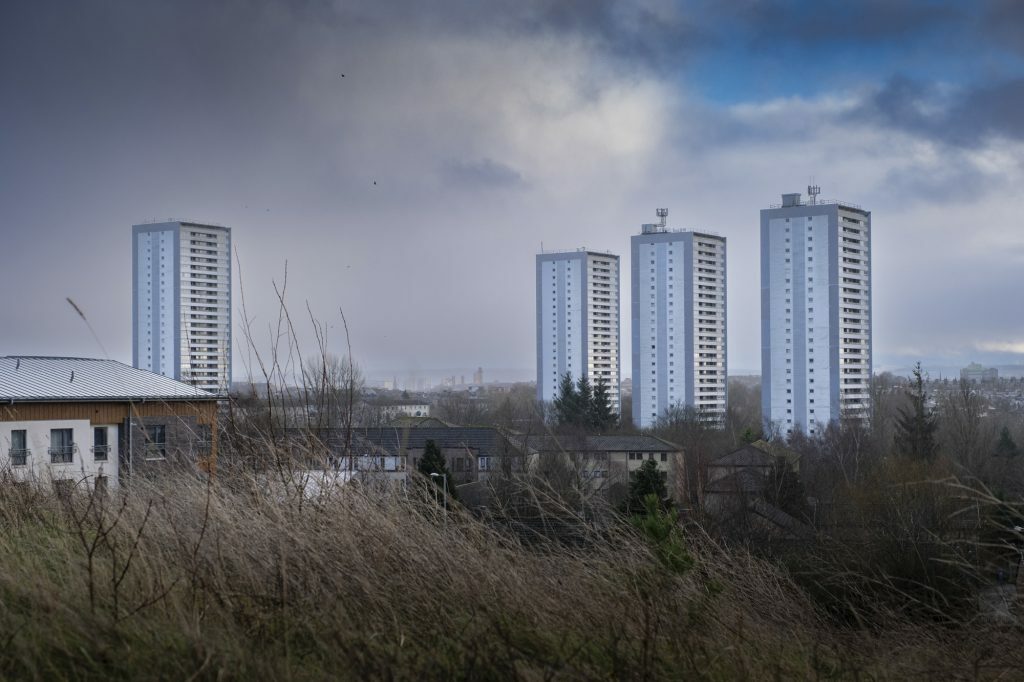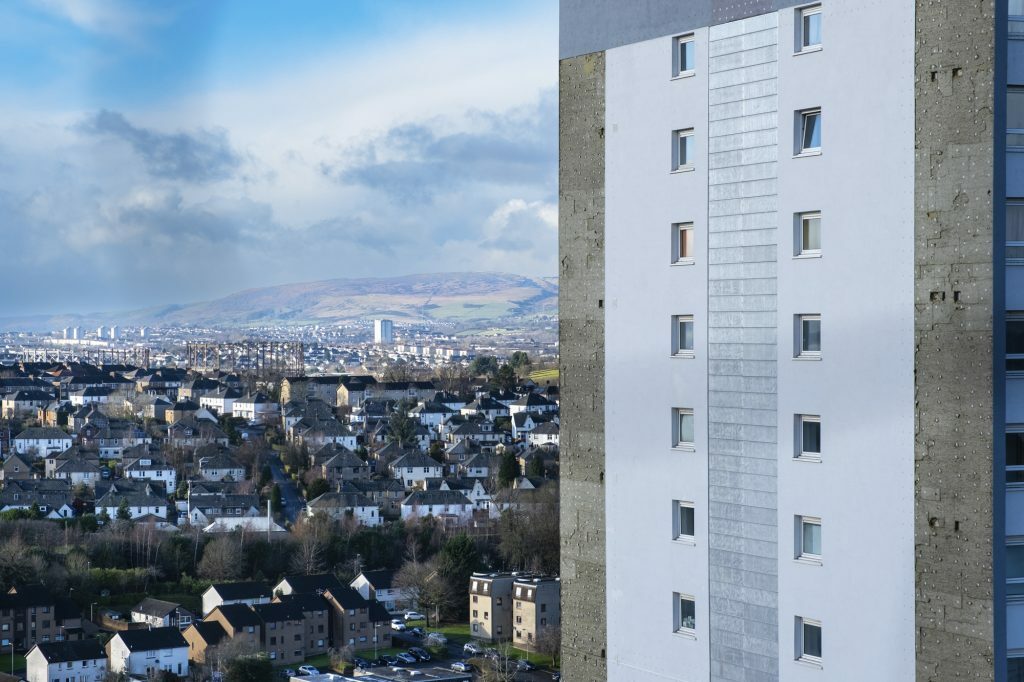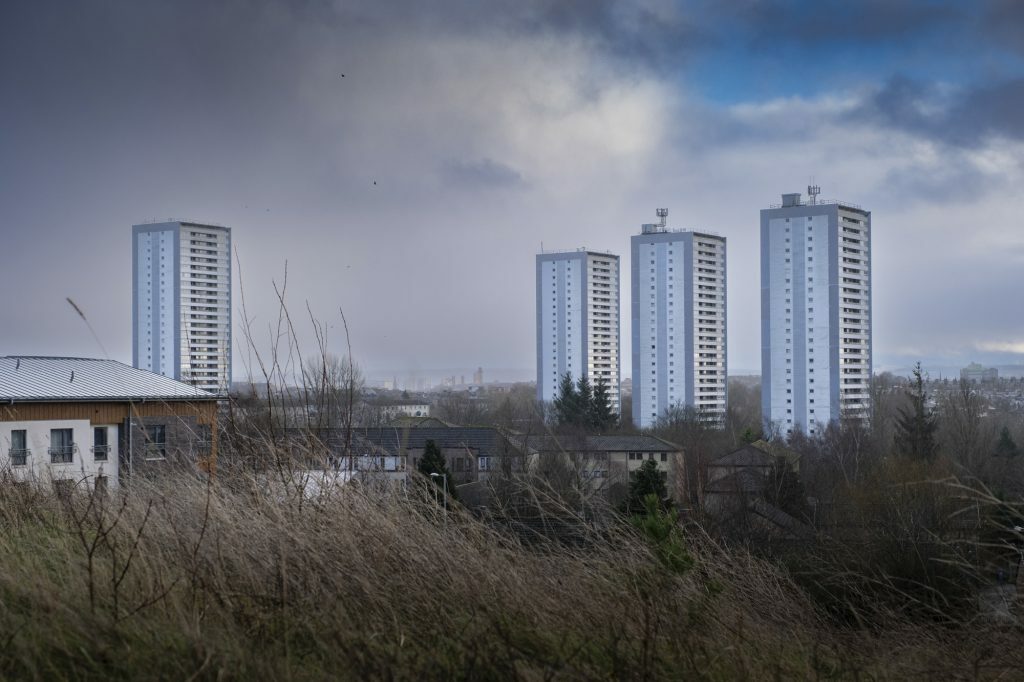High-rise demolition that turns Glasgow’s COP26 on its head
The residents of the run-down high-rises on Glasgow’s Wyndford estate are battling a proposal to demolish the towers and rebuild under the banner of ‘regeneration’. They are true climate champions, writes architect Malcolm Fraser.
Wyndford high-rise resident Norman Cunningham put it best when talking to Chris Leslie, as he took these elegiac photographs: ‘Did Cop26 actually happen? In Glasgow?’
What can we say about a Council and social landlord – the Wheatley Group, beneficiary of Glasgow Council’s housing stock transfer – who seek to demolish 600 social homes in four tower blocks in the midst of a housing crisis? A compound crisis, affecting in particular young people and the less-well paid, ‘clapped-for’ classes but also students, and leaving Ukrainian refugees crammed into floating hotels in Scotland’s docks.

Wyndford resident Daishin Stevenson, a Buddhist monk, poet and photographer. Image credit: Chris Leslie
And, as for Mr Cunningham’s comment, what can we say when that very council seeking to waste 600 homes to landfill, hosted COP26, and blandly states, in its Glasgow City Region policy statement of 2020: ‘Retrofitting our homes to make then more energy efficient offers us both a challenge and an opportunity.’ They never stint in banging-on about their green and net-zero credentials, as do the Scottish Government, which will supply our money to fund this ‘regeneration’.
The estate lies just north of the city centre and is a modernist classic, referred to by Docomomo as ‘one of the high water marks of post-war housing provision in Scotland’. It was designed by Harold Buteaux and built between 1961 and 69 for the SSHA – the Scottish Special Housing Association – which, significantly, was a national organisation, with aspirations and budgets a wee bit above a council’s and the estate has quality to match.
It totals 1,900 homes, with the to-be-retained, larger, east portion of the site a mix of 15-storey point blocks and four to nine storey maisonette slabs, nicely arranged to enclose a series of green squares with planting now fully mature. This portion has had a bit of money spent on it and looks tidy, loved and nicely-continental – a perfect Glaswegian exemplar of the brave post-war ideals of light, landscape, air and openness. The west end, next to the lovely River Kelvin and, significantly, some leafy Glasgow inner-city suburbs, has our four, brave, 26-storey towers, which have suffered a bit from inappropriate tenant placement, and have now been substantially cleared. They are down to their last, lonely 20% occupation, and have seen the surrounding landscape stripped rather than invested in, allowing their general neglect to fuel the argument for their demolition.
There is huge local resistance to this, and the first thing to make clear is that this was initiated and is led by local residents, in particular the Wyndford Residents Union, who live in and care for the place. They need no visiting architectural academics and brutalist dreamers to tell them that, first, these demolition plans are a carbon crime, for the towers are embodied and useful carbon, which can and must be saved and improved; and, second, that their estate is being socially-cleansed.

The high-rise blocks on the Wyndford estate, threatened with demolition. Image credit: Chris Leslie
Our small group offering them assistance – Kate Mackintosh, Alan Dunlop, Miles Glendinning, , some students and me, with carbon advice from social enterprise EALA Impacts – see it as good to try to understand the opposite side’s arguments, and I’ve reached out to politicians, urban champions and others to try to broker a conversation. Amongst the regeneration puff, these proponents of demolition talk about the need to improve energy performance. But the buildings already attain an EPC Rating of C, against a Scottish average of D, so they are good, and a solid platform on which simple improvement can be wrought.
And we, of course, know that high-rise retrofit can be done – has been done decently in Glasgow, for the Queen’s Cross Housing Association, and brilliantly elsewhere, like at Lacaton & Vassal’s Tour Bois le Pretre. So that point doesn’t hold water, and when pressed it’s clear that their main argument for demolition is that, just as their post-war predecessors demonised Glasgow’s stone tenements and ‘slum-cleared’ them (Swing, Hammer, Swing), they like to demonise the modernist heritage that replaced it, except with a demolition blast rather than a wrecking ball.
Famous 1960’s psychiatrist R. D. Laing wrote of his home city and its ‘violence and tenderness, and great warmheartedness’. Happily, the city, in its people, has lost some of that violence, with warmheartedness often to the fore; but still, in its approach to its built fabric, it tears at itself, every generation destroying it anew. The apogee of that violence sits like carbon porn on the Wheatley website where an extraordinary video celebrates the blowing-up of maybe two dozen tall blocks as lovingly-filmed climactic carbon gang-bangs. Did they even notice the COP that played-out in their city? Did not the tiniest hint get through, that we are past the time when we can heedlessly consume vast resources, bin them then consume more in a virtueless cycle of waste and spend? Wheatley, emboldened by the stock transfer that removes democratic scrutiny from this huge social landlord, seems keen to follow this route elsewhere, advertising for a demolition officer to lead the Wyndford project and ‘Future projects… across the Group’. They have vast holdings across Scotland, communities beware!

The upper storeys of the Wyndford estate high-rises provide views across the city and beyond. Image credit: Chris Leslie
Their second, real reason may well be monetary. Though Wheatley are constituted as a ‘not-for-profit’ it has long been dinged into our public institutions that they need to act like they are privatised and so, here, look at the site as a developer would. Development is cost-neutral for the Wheatley Group, as it is central Government funding that pays for demolition and rebuild – our money, our taxes.
But on revenue, under a simple calculation the 600 homes on the site are social rental, for nurses, bus-drivers, cleaners – as well as the retired, refugees and the odd Buddhist priest. The planned 300 replacements will be mid-market rent, remembering the leafy surroundings of the River Kelvin, and attract a higher income than the 600, thus levering our public money to raise the profit of the not-for-profit.
I’m not suggesting the ‘social cleansing’ is necessarily deliberate – the chasing-out from their city of ordinary, old and new Glaswegians. It is not the purpose and the evil plot of some malignant landlord but rather the inevitable consequence of that landlord’s disregard for their social responsibility, on top of their climate one. But – stop-press! – in the face of the residents’ vigorous campaign Wheatley are suddenly talking about more social rent, but without the trust or firm commitment needed to convince residents they will not revert to mid-market and, if true, leaving as sole motive their orgiastic love for blowing things up.
I should note the ‘consultation’ and Wheatley’s claim of ‘overwhelming support’. Consultation is important in Scotland, such as in the new National Planning Framework 4. Developers therefore need to look at how to manipulate consultation, and be sure to only consult on what they want to do. So, residents have been told about ‘a bright new dawn for Wyndford’ and asked ‘Do you want to have £73m invested in your community?’ Seventy-three million quid – what’s not to like? And, as a supporter of the campaign says, ‘far from being presented with options and ideas, or being allowed to influence the general direction, residents were asked “what excites you most about the regeneration plans?”’. The only given option for investment in the wider community was demolition: ‘Do you support the regeneration plans including the demolition of the four low demand high rises?’ was how it was worded. And residents were misled when they were told that the flats were impossible to make energy-efficient.
‘Consulting’ like this on one option, with the path already set, is not consultation but boosterism, as are the glossy leaflets the estate is being deluged with.

Docomomo describes the Wyndford estate as ‘one of the high water marks of post-war housing provision in Scotland’. Image credit: Chris Leslie
Two things, to finish. First, we need to get better at valuing carbon. Our high-level carbon analysis report found the impact of the demolition and rebuild is, at approximately 22,465 tonnes of CO2 emitted, nearly twice that of retrofitting, at 12,098 tonnes – a 10,000 tonne carbon loss to go with the loss of 300 homes overall or 600 social homes. But under the current RICS Assessment Methodology the act of demolition itself has little impact, just counting stuff like the fuel for the cranes, the TNT strapped to the building and the demolition mannie’s push on the plunger.
Such evaluation misses the impact of this virtueless cycle of waste and spend – sees no difference between useful carbon, that makes a nice home, and that wasted in a landfill site. We need to get smarter – our overlapping crises are about resource depletion and waste, as well as carbon and climate. We are talking to those leading the resistance to the downing of the ITV Building on the Thames and the M&S Building on Oxford Street, who are authoring the new RICS Methodologies due this summer. The Mayor of London now has a framework requiring a Whole Life Carbon Assessment over 60 years, and that for demolition it requires the assessment be done with 95% recycling, which will assist cases like ours as it always be expensive and, in itself, carbon-consuming. We need to spread such thinking around and lobby for such assessments to be mandatory for large development.
Lastly, we need to recognise our profession’s complicity in all this. Colleagues sometimes look askance at retrofit – not proper architecture, for where’s the glory to be gained from humble retrofit compared to a waste and spend cycle with its pontificating about style, green gizmos and good urbanism? That waste and spend thinking is right in-tune with our wider industry where, at least in the Scottish context I know, our bankers, construction conglomerates and government enablers whisper the term ‘dealflow’. This describes their wish for an unending river of public money to finance the regular decay, landfill and replacement of our public stock of homes, schools, hospitals and the like.
And I cannot be the only one who looks on some of the Profession’s parade of self-declared ‘Climate Champions’ with incredulity – whose careers embrace wholesale demolition with, sometimes, a schtick based on the conspicuous, luxurious consumption of carbon (never use a bit of wood when aluminium will do), lecturing us about how wonderfully virtuous they are because their newbuild has some whizz-bang bit of low-energy kit in it.
The active, engaged and aware residents on the Wyndford Estate are our true Climate Champions.
To sign the petition against Weatley’s proposals, visit: https://www.change.org/p/stop-wheatley-destroying-our-community and keep in touch with the campaign https://www.facebook.com/WyndfordResidents/ to hear what comes next.
This article was first published in the Architects Journal. Republished here with thanks.

Renovations of existing buildings are liable for VAT; new-builds are not, I believe, hence the desire to demolish despite any social useful-ness.
Derek, public funding is excused VAT – I know Wheatley are an arms-length, but I’m almost sure they get round it. Leaving the principal reason the delight in blowing things up.
But good point, I will check – should have…
Full resource costing is the only honest approach, until homes can be grown from seed.
Excellent article. Have signed the petition.
What a scandalous way to run a housing project. The Wheatly Group’s home page looks like an advert for a demolition company.
The business model seems to be: Take housing that was once 100% social, affordable rent. Blow it up. Give back 20% of what used to be there. Let private developers make a nice profit from the difference. The Scottish public is paying to have it’s public housing stock shrunk.
Why TF is public money and land being given away like this? We can’t afford it. We need that land for affordable housing that is truly in public ownership, not gifted to some arms-length, “not-for-profit” parasitical, developer-friendly quango.
I hope the Wyndford residents have made contact with West Whitlawburn Housing Cooperative. They managed to save their own houses from council-sponsored decline in 1990 and are still going strong. (Meanwhile, the council-run East Whitlawburn side of the estate fell into decline and demolition)
https://www.wwhc.org.uk/our-background-2/
Well said Malcolm. I recognise the consultation techniques from Caledonia HA’s takeover of Bellsmyre Dumbarton. Since taking over they’ve demolished a couple of hundred flats. and built 30. They plan to buiild more but overall there’s a net loss.
I think the driving force is a gov policy to build a certain amount of new homes. It looks good for them to just count new houses, rather than overal housing provision.
HAs say they’re investing but it’s the tenants who pay. SHR estimates that. On average, 12% of tenants rent goes on interest payments on morgages. That can only get higher as interest rates rise.
It must also constitute one of the reasons social housing tenants are not getting a rent cap.
It’s gauling to see the Green Party Minister for Tenants Rights defending the rent policy by talking the same nonsense on tenant consultation your experiencing yourself.